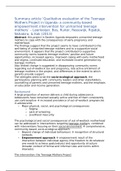Summary article ‘Qualitative evaluation of the Teenage
Mothers Project in Uganda: a community-based
empowerment intervention for unmarried teenage
mothers’ – Leerlooijer, Bos, Ruiter, Reeuwijk, Rijsdijk,
Nshakira, & Kok (2013)
Abstract: this project in Eastern Uganda empowers unmarried teenage
mothers to cope with the consequences of early pregnancy and
motherhood.
The findings suggest that the project seems to have contributed to the
well-being of unmarried teenage mothers and to a supportive social
environment. It appears that the project contributed to supportive
community norms towards teenage mothers’ position and future
opportunities, increased agency, improved coping with early motherhood
and stigma, continued education, and increased income generation by
teenage mothers.
Also limited change is suggested in disapproving community norms
regarding out-of-wedlock sex and pregnancy, late active enrolment of
teenage mothers in the project, and differences in the extent to which
parents provide support.
The strengths seem to be the socio-ecological approach, the
participatory planning with community leaders and other stakeholders,
counselling of parents and unmarried teenage mothers, and the emphasis
on education and income generation.
Background
A large proportion of women delivers a child during adolescence.
Adolescents have remained sexually active and few of them consistently
use contraceptive increased prevalence of out-of-wedlock pregnancies
in adolescents.
- Major physical, social, and psychological consequences
o Stigma
o Lack of schooling
o Livelihood insecurity
The psychological and social consequences of out-of-wedlock motherhood
can be addressed in interventions targeting teenage mothers, combined
with interventions focusing on their social environment comprehensive,
community-based, socio-ecological approach.
- Beyond change of individual behaviours recognition of structural
contexts
- Empowerment approach empowerment result of the
interaction between individual agency (the freedom to do whatever
one needs to achieve goals/values) and opportunity structure
(broader context of formal and informal rules and norms within
interests).
The intervention: the Teenage Mothers Project
, Socioeconomic standards and literacy rates are generally low.
The planning group discussed suggestions of teenage mothers and
community leaders to address certain needs, checked these with the
health promotion professional, and implemented the selected
interventions on a small scale.
The project started in 2000, based on the suggestion of unmarried
teenage mothers to support them with a female goat that would supply
them with milk to support their child, with offspring that could be traded
for a cow and that would give them respect in their family and community.
iterative project design
- Guided by Intervention Mapping Framework= stepwise planning
framework, describes iterative process of behaviour change
programme development from problem identification to problem
solving or mitigation.
Needs assessment:
- Out-of-wedlock pregnancy
- Stigma
- Violation of rights of unmarried mothers
- Unawareness of its magnitude and consequences
Major problems
Intervening among various actors: unmarried teenage mother and
parents, school administrators, religious leaders, tribal leaders,
governmental leaders on different levels, journalists and community at
large.
Programme outcome: to improve the psychological and social well-being
of unmarried teenage mothers by increasing their decision-making power
(agency) and creating a supportive environment (opportunity structure).
Behavioural outcomes:
- Effective coping with stigma and motherhood
- Continuation with education
- Income generation
- Having no or protected sex
- Advocacy for their rights
Coping addressed through emotion-focused strategies and problem-
focused strategies.
Environmental outcomes: increased support for continued education and
increased care for unmarried teenage mother and child by various
environmental actors.
5 intervention components:
1. Community sensitisation
2. Teenage mothers support groups
3. Livelihood
4. Counselling
5. Advocacy






